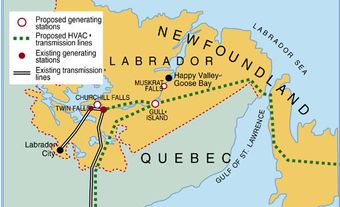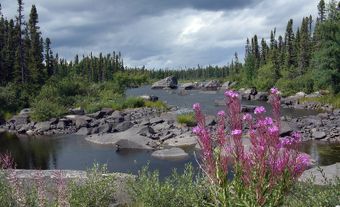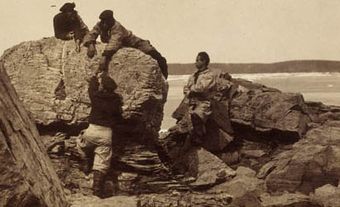Mina Benson Hubbard (née Mina Benson, also Mina Benson Hubbard Ellis), explorer, geographer, author, nurse, teacher (born 15 April 1870 near Bewdley, ON; died 4 May 1956 in the County of Surrey, England). After her husband died while exploring the interior of Labrador, Mina Benson Hubbard embarked on an expedition to complete his work. She completed the nine-week canoe journey through at least 900 km of Labrador in 1905. Hubbard was one of the first non-Indigenous people to travel extensively in the area. Using measurements and notes taken during her trip, she developed some of the first maps of the region.
Early Life and Education
Mina Benson was born to Irish and English parents on a farm near Bewdley, Ontario, near Rice Lake. She was one of eight children. Hubbard was educated in a one-room schoolhouse near her home before attending high school in Cobourg. She spent a decade teaching elementary school. After leaving education, Hubbard attended the Brooklyn Training School for Nurses in New York, graduating in 1899.
Marriage to Leonidas Hubbard
While working as an assistant superintendent at S.R. Smith Infirmary on Staten Island, New York, Mina Benson met Leonidas Hubbard Jr. in May 1900. Leonidas, a journalist, was recovering from typhoid fever in the hospital. The couple married in New York in January the following year. Both Mina and Leonidas enjoyed the outdoors and spent their honeymoon camping.
During their marriage, Leonidas worked as a journalist for Outing, an American outdoors and sporting magazine. Inspired by stories of Arctic exploration and the desire to make a name for himself, he embarked on a journey through the interior of Labrador. In the early 20th century, Labrador was one of the last parts of North America to remain largely unmapped and unvisited by non-Indigenous people. Leonidas and his friend Dillon Wallace, a lawyer from New York, hired Cree-Scots guide George Elson for their journey. Their expedition began in July 1903. From nearly the outset, the group was lost, having turned down the wrong river and ending up in a maze of lakes. In October, Leonidas died from starvation and exhaustion in the interior of Labrador. Elson managed to make it back to the nearest settlement and successfully got help to rescue Wallace. Elson and Wallace both later returned to New York in May 1904. After his return, Wallace published a book, The Lure of the Labrador Wild (1905), which portrayed Leonidas poorly.
1905 Expedition to Labrador
After her husband’s death, Mina Benson Hubbard decided to embark on the same expedition to Labrador. This was done in part to complete Leonidas’s work and to clear his name after Dillon Wallace’s negative account. Hubbard had no previous experience in exploration or geography. She hired George Elson, the guide on Leonidas’s expedition, who knew that the inaccurate maps and information had led to disaster the last time. Elson enlisted the help of three other Indigenous men, Job Chapies, Joseph Iserhoff and Gilbert Blake, for the trip. Wallace also planned to attempt the journey again the same year, and the press painted it as a rivalry between the two parties.
On 27 June 1905, Hubbard departed from North West River, Labrador, to begin her expedition. Wallace’s party had left about a day earlier but took a different route. Over nine weeks, she covered at least 900 km by canoe to the George River Hudson’s Bay Company post at Ungava Bay, North-West Territories (now Northern Quebec). Hubbard’s party reached Ungava Bay on 27 August. Wallace’s party did not arrive for another seven weeks. Hubbard returned home via a supply ship that visited Ungava Bay just once a year.
Packing List
In her 1908 account of the journey, A Woman’s Way through Unknown Labrador, Mina Benson Hubbard detailed what her five-person party brought along for their nine-week expedition. The packing list included:
- Two 19 foot (5.8 m) canoes
- Two balloon-silk tents
- 1 stove
- 7 waterproof canvas bags
- Twelve 10-lb. waterproof balloon-silk bags
- 3 tarpaulins
- 392 lb. flour
- 4 lb. baking powder
- 15 lb. rice
- 20 cans standard emergency rations
- 12 lb. tea
- 12 lb. chocolate
- 60 lb. sugar
- 20 lb. erbswurst (sausage)
- 4 cans condensed milk
- 4 cans condensed soup
- 5 lb. hard tack
- 200 lb. bacon
- 14 lb. salt
Expedition Work
Throughout the journey, Mina Benson Hubbard kept notes in her field journal. She detailed her experience and observations about the flora and fauna of the region, the great Labrador caribou migration and encounters with the Innu. Hubbard also took more than 300 photographs with her Kodak cameras.

Hubbard took measurements during her trip, which allowed her to correctly map the region’s rivers, lakes and tributaries. The geographical societies in America and Britain accepted the map she drew from her journey. This map was used until the 1930s, when aerial photography allowed for more accurate versions. Hubbard’s work proved that the Naskaupi and North West rivers were the same river, and that Seal Lake and Michikamau Lake shared the same drainage basin. After the expedition, Hubbard named several geographic features she encountered after family members, such as Lake Agnes, Marie Lake and Maid Marion Falls. She named Hubbard Lake in what is now Quebec after her late husband.
“The trail led down into a valley opening eastward to Seal Lake, and walled in on three sides by the hills. On either hand reaching up their steep slopes were the spruce woods with beautiful white birches relieving their sombreness, and above — the sheer cliffs. A network of little waterways gave back images of delicate tamaracks growing on long points between. Not a leaf stirred, and silence, which is music, reigned there. The valley was flooded with golden light, seeming to hold all in a mysterious stillness, the only motion the rapids; the only sound their singing, with now and again the clear call of a bird.”
— Mina Benson Hubbard, A Woman’s Way through Unknown Labrador (1908)
Post-Expedition Life
After returning from Labrador, Mina Benson Hubbard published accounts of her journey in magazines and a book, A Woman’s Way through Unknown Labrador (1908). She also embarked on lecture tours in North America and England. During her tour in England, she met her second husband, Harold Ellis, who came from a wealthy Quaker family. The couple married in 1908 and had three children before divorcing in 1926.
In England, Hubbard was involved with the women's suffrage movement. In 1927, she was made a Fellow of the British Royal Geographical Society. Hubbard lived in England for the rest of her life but frequently travelled back to Canada. One visit in 1936 involved a canoe trip down Moose River in northern Ontario with her former guide, George Elson.
Hubbard died on 4 May 1956, at age 86, after being hit by a train in England.
Honours
The town of North West River, Labrador, where Hubbard began her journey, and Memorial University of Newfoundland’s Centre for Newfoundland Studies celebrated the 100th anniversary of her expedition with a series of events in the summer of 2005. In 2018, the Government of Canada designated Hubbard a National Historic Person.
(See also Mina Benson Hubbard's Labrador Expedition.)

 Share on Facebook
Share on Facebook Share on X
Share on X Share by Email
Share by Email Share on Google Classroom
Share on Google Classroom








